Starting a new adventure on The Continent with Rance 01
A little while ago, I argued that adult games deserved the same time and attention as mainstream games, and I specifically cited the Rance series as one that deserves particular scrutiny. We’ve taken a passing glance at several installments in the series over in the History of Lewd column — specifically, Little Princess (regarded as kind of sort of the “prologue” to the whole series’ lore), Rance 5D: The Lonely Girl and Rance VI: Collapse of Zeth — but I think it’s time we dove into the series proper with a full-on deep dive. So that’s what we’re doing today with our first look at Rance 01: Quest for Hikari.
The Rance series follows the many exploits of the somewhat morally ambiguous (to say the least) adventurer Rance and his slave Sill Plain, beginning with his early life as an adventurer for hire and gradually developing onwards to depict his rise to power and prominence in the series’ world of The Continent. While each game’s story very much stands by itself, the series in its entirety tells the complete story of Rance’s career, and as such there’s great value to be derived from starting at the beginning and working your way through.

Not only that, but each game in the series provides a markedly different experience from the last. We’re not just talking in terms of narrative and setting here; we’re talking full-on complete reinventions of mechanics and game structure. And that’s one of many things that makes the series as a whole absolutely fascinating to explore.
Rance 01: Quest for Hikari (Rance 01 hereafter) is a modern remake of the first Rance game. That original game was first released on the PC-8800, PC-9800, Sharp X68000, MSX 2 and 2+, FM Towns and PC88VA Japanese home computers, and was subsequently ported to Windows 95 machines in the late ’90s. These original versions never came west, though; as many of you reading will likely already know, we didn’t get even a whiff of an official Rance over here in the west until 2016, when MangaGamer brought both 2002’s Rance 5D: The Lonely Girl and 2004’s Rance VI: Collapse of Zeth to English-speaking audiences in a double pack.
The reason for this is that Rance 5D acted as something of a “soft reboot” of the series; the “D” in its title represents the fact that it was the fourth attempt to make a fifth Rance game after a six-year hiatus. As such, despite technically being from slap bang in the middle of the series as a whole, it was actually quite a good place to start.
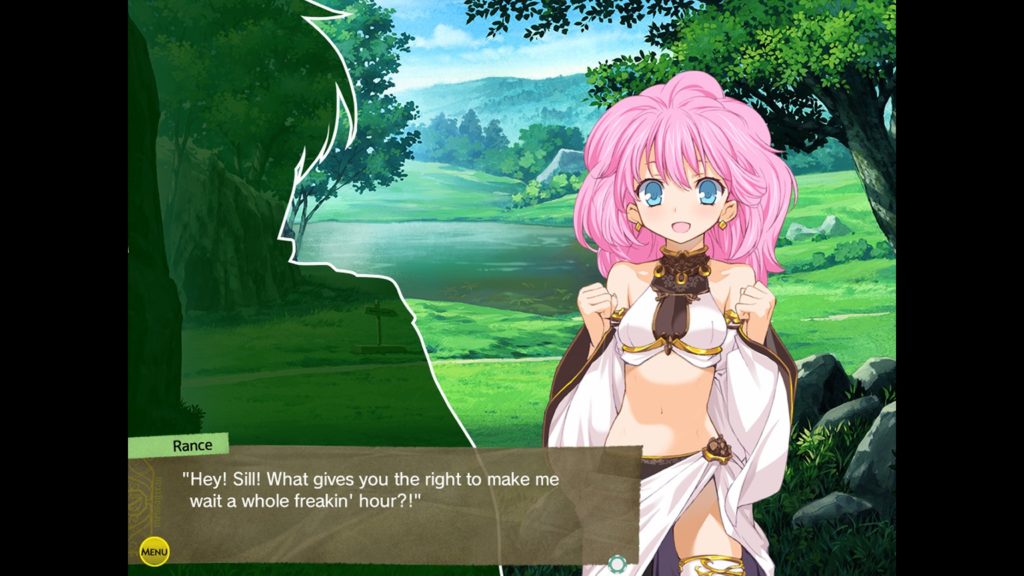
Although it’s a remake of the second-oldest game in the series (assuming you count Little Princess), Rance 01 is actually one of the more recent releases, first appearing to Japanese audiences in 2013. Prior to that, Rance II: The Rebellious Maidens had enjoyed a remake in 2009 (as “Rance 02” to distinguish it from the original release, much like Rance became Rance 01).
Rance 01 was designed to provide a further enhanced experience over Rance 02, with additional things to do in the game and a narrative context that better fits with the established series canon as seen in the later installments. (Rance 02 later got another rerelease designed in a similar fashion to Rance 01, known as Rance 02 Kai, but more on that when we get to it.)
Anyway, enough context: what’s Rance 01 all about? Well, it kicks off with a young Rance, about 18 years of age and still relatively new to the whole adventuring thing, being given an assignment to locate a kidnapped girl named Hikari. Although young Rance is already in possession of a formidable ego, he knows that he can’t afford to be too choosy about his jobs — and since this one involves a cute girl, he accepts.
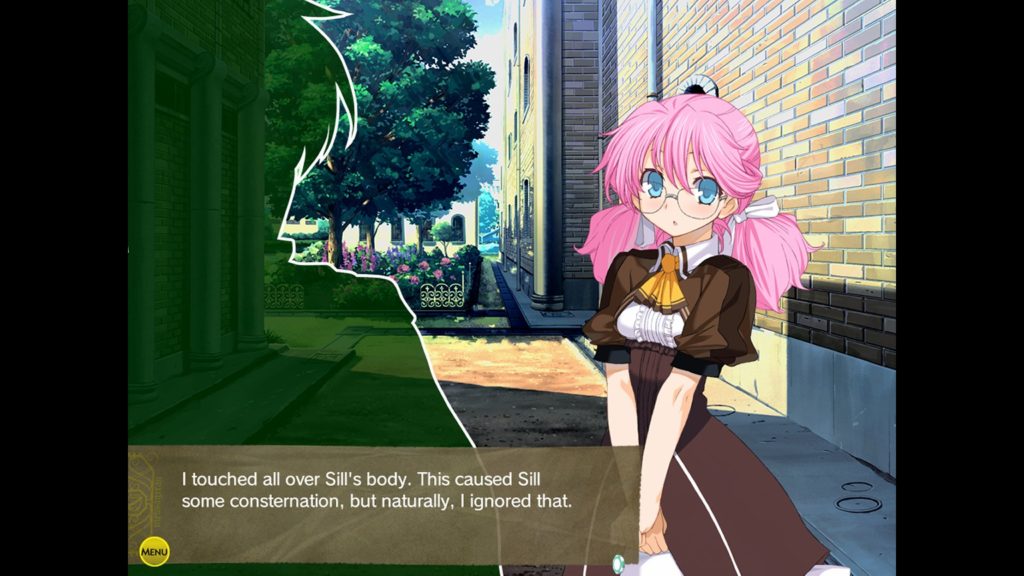
Upon arriving at the castle town of Leazas, where Hikari attended school, Rance immediately sends his slave Sill Plain off to pose as a student at the local academy and discreetly uncover some information while he prepares for some serious adventuring of his own.
Unfortunately, he realises too late that he sent Sill off in possession of his coin purse — and she subsequently spends all his money on admission fees for the academy — and so upon arriving at the local inn, he’s forced to give up his favourite sword as collateral for the room until he’s able to pay up properly. Not a great start, but he’s a resourceful sort of chap; adventurers are nothing if not good at making a bit of money, after all, even if it’s just by whacking a few local monsters on the head.
We’ll talk more about the overall narrative of the game another time; for now let’s talk a bit about the game’s overall structure, because it’s quite an unusual but effective means of approaching a game like this.
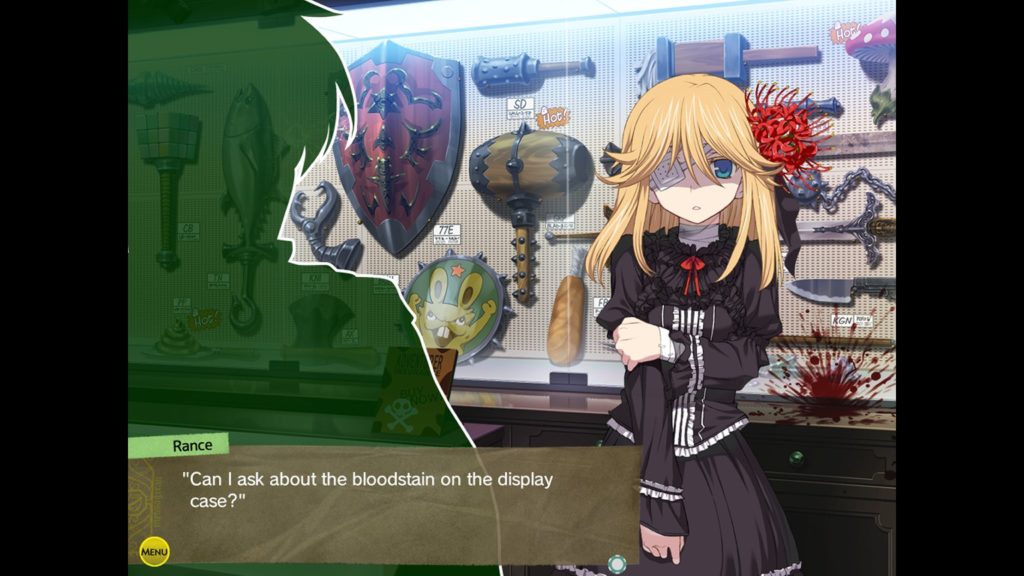
At heart, the various installments in the Rance series are RPGs, but the early games in particular skewed quite heavily towards the “Japanese adventure game” angle. Rance 01 is no exception to this; many sequences unfold in what is referred to as “ADV mode”, where you have the option of interacting with people and things in the area Rance currently occupies by using several options. In the Japanese original, these corresponded to various body parts — eyes, mouth, hands, “attack” and feet — while in the localised version more conventional verbs such as look, talk, touch, move and, erm, “assault” are used.
You’ll uncover information by using each of these options and unlocking additional things to interact with. While the “Assault” option is very much in keeping with Rance’s reputation, it’s worth noting that more often than not — particularly in the early hours of the game — attempting to make use of it for sexual harassment purposes in civilised areas tends to result in quite humorous scenes at our hero’s expense. It’s also used in a non-sexual sense as a means of simply outright attacking potential enemies rather than finding a non-violent means of getting past them.
There’s a time system at play in Rance 01. Each location you visit in Leazas takes up one unit of time, with each day being split into a total of nine units: three morning, three daytime, three night. Reach the final “night” time unit and your only option is to go to bed, unless you happen to be out adventuring in the wilds when this happens; at this point, Rance will get deliriously knackered and you’ll need to try and get him safely back to town so he can get some rest before carrying on.
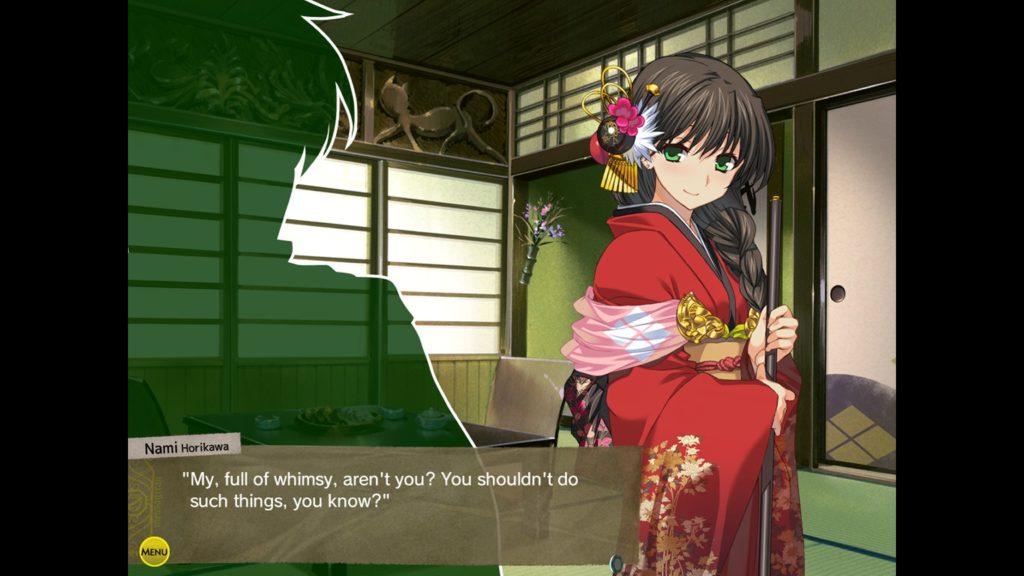
The time system is also relevant in that certain locations are only open at certain times of day, and certain events only occur at specific times, also. The game doesn’t force you to micromanage time to such a degree that you need to, say, be in the park at exactly 8:30pm; the most specific you’ll have to get is “be at this place in the morning/daytime/night” — the exact time doesn’t matter too much, and aside from a few optional events, the game doesn’t provide a time limit for your overall quest.
Outside of Leazas itself, Rance makes use of an interesting, peculiar method of exploration that ties in with the game’s overall “gambling” aesthetic. You’re presented with five stacks of cards, with Rance in the middle “lane”. Each turn, Rance can choose either the card in front of him, or to move one lane left or right and choose that card instead. Many cards are already visible, allowing you to plan out your route to a certain degree, but some are face-down and must be flipped over to reveal what they are.
Cards can simply be blank locations in which nothing happens, or they can trigger various events. Battle cards are marked with a letter grade indicating the relative difficulty of the encounter; purple cards represent traps; dark grey cards are impassable obstacles; cyan cards represent special locations that often feature important events or at the very least useful happenings.

The stacks of cards will eventually loop, so you can learn their overall layouts — key locations such as the cyan cards and the cards which allow you to return to town are always in the same place, but there’s a light degree of randomisation on some of the others.
Certain cards will also lead to new “locations”, which leads to new arrangements of cards that need to be explored independently; a good example comes early in the game, where Rance learns that there’s a gang of thieves hanging out nearby. By landing on a “Cave” card, Rance can enter the thieves lair; the time of day when he arrives determines if he needs to survive a tough combat encounter first, or if he can just sneak in. Regardless, so long as he’s successful, he’s then into a whole new “dungeon” with a new arrangement of cards to explore.
It’s simple and abstract, but very effective, and after some time you start to get a real feel for the “geography” of each area, which in turn lets you plan out your expeditions a bit better according to whether you’re heading out to grind or with a specific objective in mind.
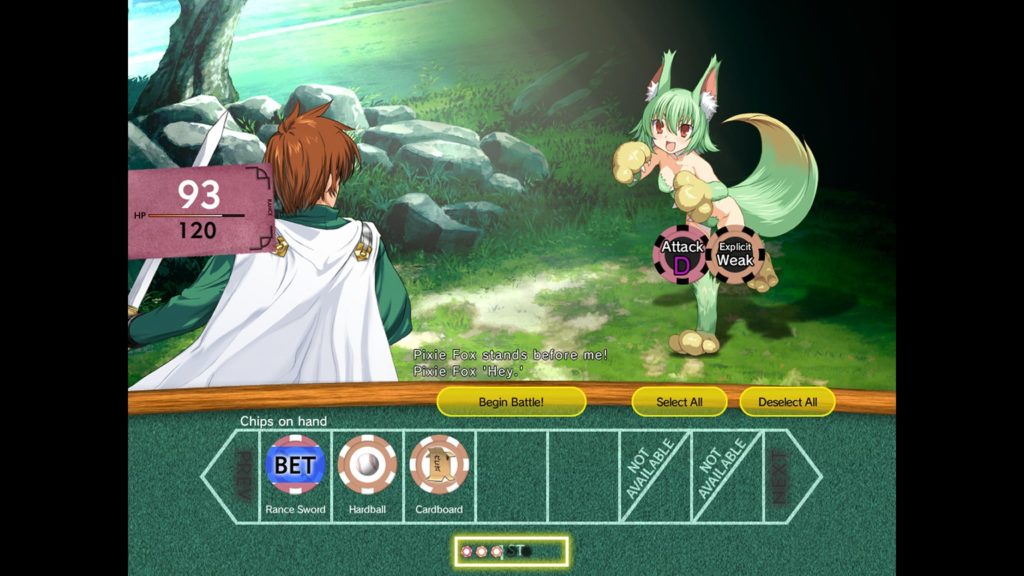
Combat also ties in with the gambling aesthetic established by the cards, the green baize backdrop and the roulette wheel-style clock. Rance fights alone, since Sill is off carrying out her own investigation at the academy, and his available abilities are represented as poker chips. Some of these, like weapons, can be repeatedly re-used — and, moreover, multiple can be used in a single turn — while others are single-use consumables. Likewise, some chips have a cooldown before they can be used again, while others can be used every turn without penalty.
With this in mind, you’ll need to carefully build Rance’s “deck” of chips in such a way that he can both deal significant damage to enemies and keep himself safe. This provides plenty of interesting strategic decisions, because Rance only has a limited number of slots to carry chips with him. This limit expands as Rance levels up — and temporarily unneeded chips can be stored in the closet back at Rance’s inn room — but certainly early in the game you’ll need to take care to have an efficient deck that doesn’t leave you too vulnerable.
Because yes, Rance 01 is not afraid to kill you off — though thankfully a fairly generous autosave system does mean that you’ll rarely lose a lot of progress if you do happen to bite the big one. You’ll find quite early on that you’ll need to find a reliable means of beefing Rance up a bit before taking on more significant challenges; this doesn’t just mean grinding for money and experience, but also figuring out a good combination of items to carry with you and arming yourself accordingly.
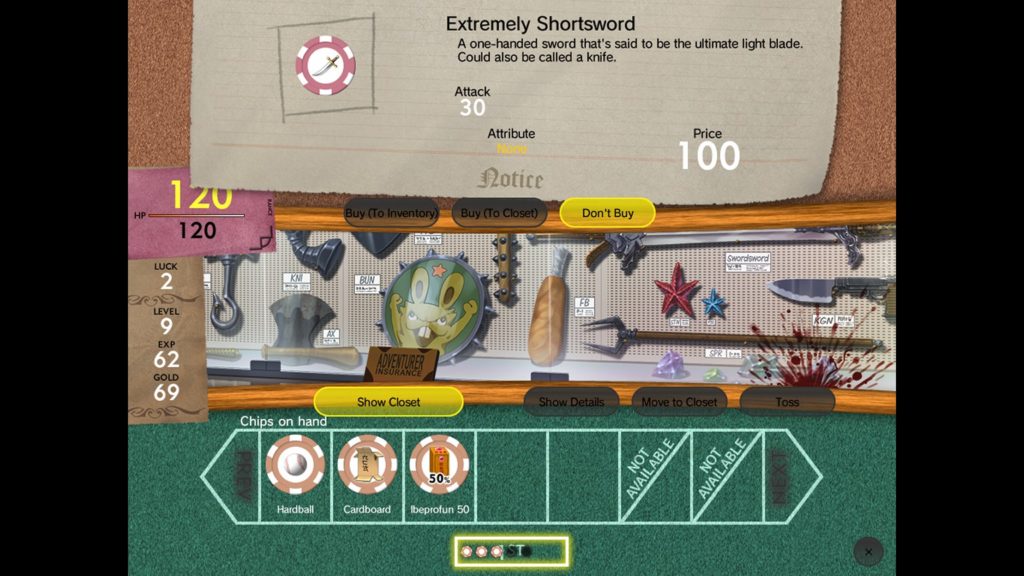
There are plenty of options to choose from, and none of the shops in the game are simple, boring interfaces, either; each is staffed by a distinctive character with their own story to tell and their own lineup of items that expands and changes as you progress through the game. A particular highlight is the robotic AI girl whose speech is constantly punctuated with keyphrases from PC-88 BASIC — an homage to the series’ roots on that platform.
Like other games in the series, levelling up is a manual process that requires Rance to visit a “Level Shop” and perform a ritual in order to get stronger. Recurring character Willis is introduced here, and she’s good enough to flag you down in town if you have enough experience to level up but you haven’t paid her a visit yet. Levelling up mainly increases Rance’s HP, but also occasionally increases his Luck stat and ability to carry more chips. At various level milestones, he’ll also acquire special coins that he must take to a statue out in the wild in order to acquire helpful passive abilities.
Rance 01 is a relatively short game compared to later games in the series, but that’s in keeping with the relatively small-scale nature of the story it has to tell. One of the particularly appealing things about the series in its entirety is how it develops in scale and scope over time — both in terms of what you, as the player, get to experience, and what Rance is actually getting up to as part of the narrative.

So that’s a first look at the Rance 01 experience; we’ll return to this soon to take a closer look at various aspects of the game and its narrative, and how it all fits into the context of Rance as a whole. And from there, we’ll continue to explore the rest of the series — though with Rance 03 having only just been announced for localisation (and Rance IV not having had a remake yet), we may end up having to jump around a bit!
With that in mind then, I’m off for some more adventure. Toooohhhh!!
Rance 01 is available in a double pack with Rance 02 from MangaGamer in both digital and physical format.
Join The Discussion
Rice Digital Discord
Rice Digital Twitter
Rice Digital Facebook
Or write us a letter for the Rice Digital Friday Letters Page by clicking here!
Disclosure: Some links in this article may be affiliate links, which means we may earn a small commission if you make a purchase after clicking on them. This is at no additional cost to you and helps support Rice Digital!
- Letter from the Editor: passing the torch - June 30, 2023
- Super Woden GP 2 is looking promising - June 30, 2023
- Inti Creates is making a 32 bit-style Love Live action platformer - June 26, 2023







